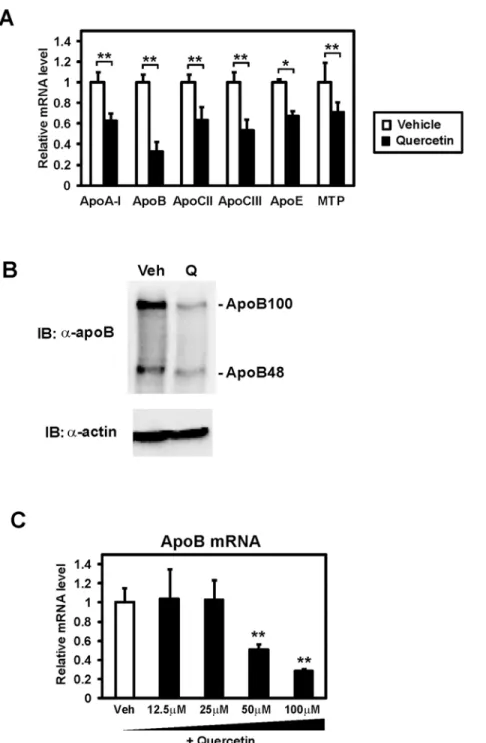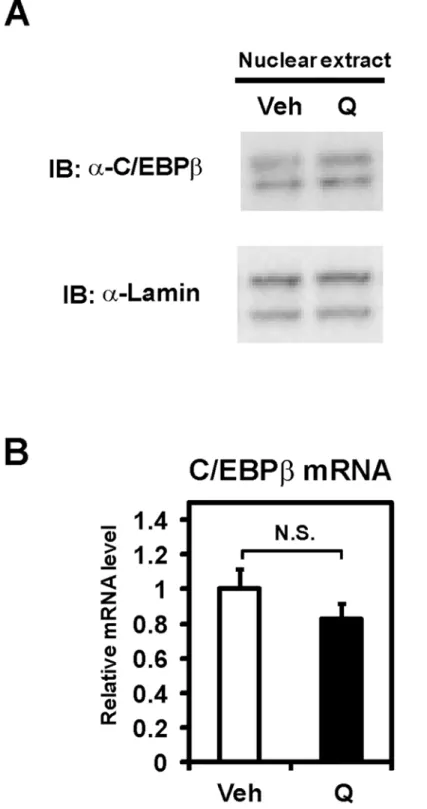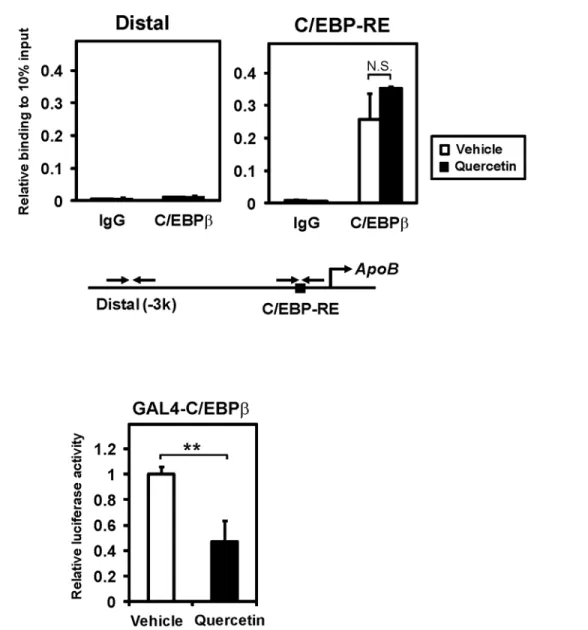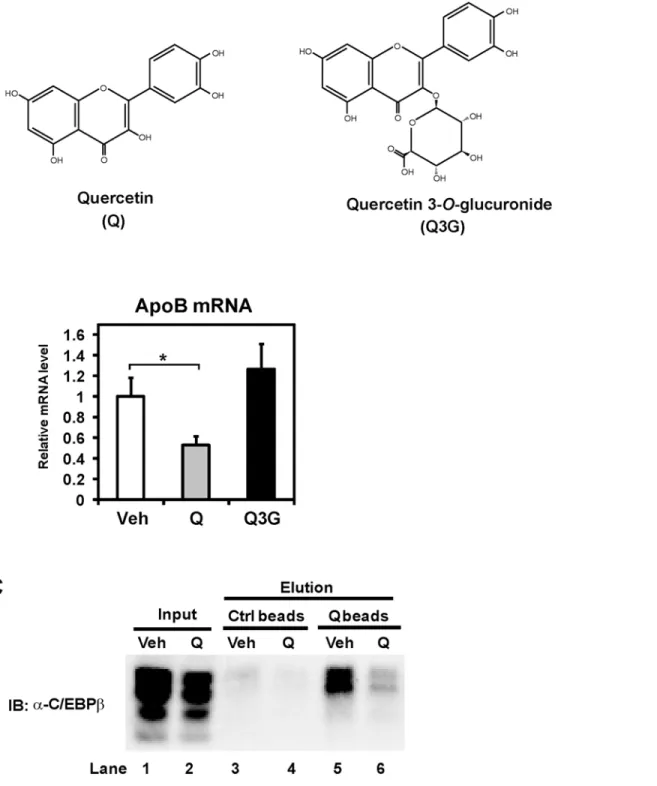Quercetin Represses Apolipoprotein B
Expression by Inhibiting the Transcriptional
Activity of C/EBP
β
Makoto Shimizu☯, Juan Li☯, Jun Inoue, Ryuichiro Sato *
Department of Applied Biological Chemistry, The University of Tokyo 1-1-1 Yayoi, Bunkyo, Tokyo, Japan
☯These authors contributed equally to this work. *aroysato@mail.ecc.u-tokyo.ac.jp
Abstract
Quercetin is one of the most abundant polyphenolic flavonoids found in fruits and vegeta-bles and has anti-oxidative and anti-obesity effects. Because the small intestine is a major absorptive organ of dietary nutrients, it is likely that highly concentrated food constituents, including polyphenols, are present in the small intestinal epithelial cells, suggesting that food factors may have a profound effect in this tissue. To identify novel targets of quercetin in the intestinal enterocytes, mRNA profiling using human intestinal epithelial Caco-2 cells was performed. We found that mRNA levels of some apolipoproteins, particularly apolipo-protein B (apoB), are downregulated in the presence of quercetin. On the exposure of Caco-2 cells to quercetin, both mRNA and protein levels of apoB were decreased. Promoter analysis of the humanapoBrevealed that quercetin response element is localized at the 50
-proximal promoter region, which contains a conserved CCAAT enhancer-binding protein (C/EBP)-response element. We found that quercetin reduces the promoter activity ofapoB, driven by the enforced expression of C/EBPβ. Quercetin had no effect on either mRNA or protein levels of C/EBPβ. In contrast, we found that quercetin inhibits the transcriptional ac-tivity of C/EBPβbut not its recruitment to the apoB promoter. On the exposure of Caco-2 cells to quercetin 3-O-glucuronide, which is in a cell-impermeable form, no notable change in apoB mRNA was observed, suggesting an intracellular action of quercetin.In vitro inter-action experiments using quercetin-conjugated beads revealed that quercetin binds to C/ EBPβ. Our results describe a novel regulatory mechanism of transcription of apolipoprotein genes by quercetin in the intestinal enterocytes.
Introduction
Quercetin is one of the most abundant flavonoids present in a wide variety of fruits and vegeta-bles, including onions, and has several beneficial properties against metabolic diseases through
anti-oxidative and anti-inflammatory effects [1]. Several studies demonstrated that oxidative
stress and other reactive oxygen species play important roles in the development of cancer, OPEN ACCESS
Citation:Shimizu M, Li J, Inoue J, Sato R (2015) Quercetin Represses Apolipoprotein B Expression by Inhibiting the Transcriptional Activity of C/EBPβ. PLoS ONE 10(4): e0121784. doi:10.1371/journal. pone.0121784
Academic Editor:Andre van Wijnen, University of Massachusetts Medical, UNITED STATES
Received:October 6, 2014
Accepted:February 4, 2015
Published:April 15, 2015
Copyright:© 2015 Shimizu et al. This is an open access article distributed under the terms of the
Creative Commons Attribution License, which permits unrestricted use, distribution, and reproduction in any medium, provided the original author and source are credited.
Data Availability Statement:All relevant data are within the paper and its Supporting Information files.
neurodegenerative disease, and diabetes. Among polyphenolic flavonoids, quercetin and luteo-lin show the strongest anti-oxidative activity. Moreover, the anti-diabetic effects of quercetin
against type 1 [2] and type 2 [3] diabetes have been reported. Although quercetin exerts
benefi-cial effects on metabolic diseases, few molecular targets of quercetin have been identified. The small intestine is a major absorptive tissue of dietary nutrients. After their intestinal absorption, the flavonoids among them are likely to be conjugated and excreted efficiently in the urine,
re-sulting in a lower accumulation of quercetin in the body [4–6]. Because concentrated food
con-stituents may be present in the small intestinal epithelial cells, food factors may exert a more profound effect in this tissue compared with other organs.
In this study, we performed mRNA profiling to identify novel targets of quercetin in the in-testinal enterocytes. We found that quercetin reduces the gene expression of apolipoproteins, including apolipoprotein B (apoB), in the human intestinal epithelial Caco-2 cells. Both mRNA and proteins of apoB were decreased by the quercetin treatment. Promoter analysis of
the humanapoBshows that a CCAAT enhancer-binding protein(C/EBP)-response element is
important for the quercetin action. Futhermore, we found that quercetin binds C/EBPβ
pro-tein, thereby inhibiting its transcriptional activity. These results demonstrate a novel mecha-nism underlying the transcriptional regulation of apolipoprotein genes by quercetin in the small intestine.
Materials and Methods
Materials
Quercetin was obtained from Jena Bioscience. Quercetin 3-O-glucuronide and the protease
in-hibitor cocktail were obtained from Sigma.
Antibodies
Anti-apoB antibody (ab7616) was obtained from Abcam, anti-β-actin antibody (A5441) was
obtained from Sigma, anti-C/EBPβantibody (sc-150) was obtained from Santa Cruz
Biotech-nology, and anti-lamin antibody (2032) was obtained from cell signaling technology.
Cell culture
Caco-2 cells were maintained in medium A (Dulbecco’s modified Eagle’s medium supple-mented with 10% fetal bovine serum, non-essential amino acids, 100 units/mL penicillin, and 100μg/mL streptomycin) at 37°C in an atmosphere containing 5% CO2. Except for
transfec-tion experiments and chromatin immunoprecipitatransfec-tion (ChIP) assays, cells that had been cul-tured for 14 days after confluency were considered differentiated. HepG2 cells were
maintained in medium B (Dulbecco’s modified Eagle’s medium supplemented with 10% fetal
bovine serum, 100 units/mL penicillin, and 100μg/mL streptomycin) at 37°C in an atmosphere
containing 5% CO2. Caco-2 cells and HepG2 cells were purchased from ATCC.
Plasmids
Luciferase reporter plasmids for human apoB promoters were constructed using KpnI/BglII
PCR fragments coding for the indicated 50-untranslated regions of humanapoBinto a
pGL3-Basic vector (Promega). A luciferase reporter plasmid for C/EBP-response element (C/ EBP-RE) was constructed using a double-stranded DNA coding four copies of C/EBP-RE of
mouse C/EBPαpromoter into a pGL3 promoter vector containing the promoter for simian
virus 40 (SV40) (Promega). An expression plasmid for GAL4-hC/EBPβ(amino acid residues
1–345) was constructed by inserting a PCR fragment, which encodes human C/EBPβinto an
in study design, data collection and analysis, decision to publish, or preparation of the manuscript.
Competing Interests:The authors have declared
expression plasmid for the DNA-binding domain of the yeast transcription factor GAL4 (pCMX-GAL4).
An expression plasmid for pcDNA-hC/EBPβwas provided by Dr. Hidetoshi Hayashi. A
re-porter plasmid for yeast GAL4 (TK-MH100x4-Luc) and an expression plasmid for pCMX-GAL4 were provided by Drs. David J. Mangelsdorf and Steven A. Kliewer.
Co-transfection and luciferase assay
Caco-2 cells were placed in a 12-well plate at a density of 1.5 × 105cells/well, cultured with
me-dium A for 24 h, and then transfected with 500 ng of one of the reporter plasmids and 500 ng
of pCMV-β-Gal, an expression plasmid forβ-galactosidase, using the calcium phosphate
meth-od. For co-transfection experiments, 250 ng of one of the reporter plasmids, 250 ng of
pCMV-β-Gal, and 500 ng of each of the expression plasmids were added. Twenty four hours after
transfection, medium was replaced with medium A and vehicle or the indicated compounds
were added. After incubation for an additional 24 h, the luciferase andβ-galactosidase activities
were determined, as described previously [7]. Normalized luciferase values were determined by
dividing the luciferase activity by theβ-galactosidase activity.
Western blot analysis
Caco-2 cells were differentiated by continuous culture for 14 days after they reached con-fluency. After treatment, cells were harvested, and western blot analysis was performed, as de-scribed previously [8].
Real time PCR
Total cell RNA was extracted using ISOGEN (NIPPON GENE) according to the manufactur-er’s instructions. The high capacity cDNA reverse transcription kit (Applied Biosystems) was used to synthesize and amplify cDNA from total RNA. Quantitative real-time PCR (SYBR green and TaqMan) was performed using an Applied Biosystems 7000 sequence detection sys-tem. Relative mRNA levels were determined by normalizing to the 36B4 transcript. The
se-quences of the primer sets used in this study were as follows: 36B4 [9],50-TGCATCAGTACC
CCATTCTATCA-30and50-AAGGTGTAATCCGTCTCCACAGA-30; apoB [10],50-GCCATT GCGACGAAGAAAATA-30and50-TGACTGTGGTTGATTGCAGCTT-30; apoCII,50-TGGGAGT CAGCAAAGACA-30and50-GCCTGTGTAAGTGCTCATG-30; apoCIII,50-GCTCAGTTCATCC CTAGA-30and50-CGGCCTCTGAAGCTCG-30; apoE,50-TGCGTTGCTGGTCACATTC-30and
50-TCTGTCTCCACCGCTTGCT-30; and MTP,50-TGTGCTTTTTCTCTGCTTCATTTC-30
and50-GCTTGTACAGCCGGTCATTATTT-30. The TaqMan ID number for apoA-I is
Hs00163641_m1.
ChIP assay
Caco-2 cells were grown in 10-cm dishes with medium A to confluency, followed by treatment
with vehicle or 100μM quercetin for 10 h. The cells were then processed for ChIP assay using a
reagent kit (Millipore), as recommended by the manufacturer. Immunoprecipitation was
per-formed with normal rabbit IgG (Santa Cruz Technology) or an anti-C/EBPβantibody (Santa
Cruz Technology). Real time PCR used the following primers: human apoB C/EBP-RE,50
-CTTCAAGGCTCAAAGAGAAGCC-30and50-AGGTCCCGGTGGGAATG-30and human apoB
distal region,50-GGGCACAGTTCCATCTACAA-30and50-CCTATCTCGTTTCTGCCTAT
Binding assay using quercetin-conjugated beads
Quercetin-conjugated agarose beads and their control beads were provided from RIKEN
NPDepo [11]. After Caco-2 cells were treated with vehicle or 100μM quercetin for 12 h, cells
were collected with the binding buffer [10 mM Tris-HCl (pH 7.6), 50 mM KCl, 5 mM MgCl2, 1
mM EDTA, and a protease inhibitor cocktail]. Cell lysates (1 mg of protein) were precleared by
control beads (10μl) and then incubated with quercetin beads or control beads (15μl) for 12 h
at 4°C. The reacted beads were washed with the binding buffer, and co-precipitated proteins were detected by western blot analysis.
Statistical analysis
All results are presented as mean ± standard deviation (±SD) and evaluated using the Student’s
t-test. Significance was assumed at p<0.05 and p<0.01.
Results
Expression of apolipoproteins is decreased by quercetin
Human intestinal epithelial Caco-2 cells were used to identify novel targets of quercetin in the intestinal enterocytes. Total RNA was prepared from differentiated Caco-2 cells cultured with 100μM quercetin for 24 h. Then mRNA levels of several genes related to lipid metabolism were analyzed by quantitative real time PCR. This mRNA profiling revealed that the gene ex-pression of some apolipoproteins, including apolipoprotein A-I (apoA-I) and apoB, was
signif-icantly decreased by quercetin (Fig 1A). In addition, we observed downregulation of gene
expression of microsomal triglyceride transfer protein (MTP), which has a crucial role in chy-lomicron and very low density lipoprotein (VLDL) assembly. Because apoB expression was markedly suppressed by quercetin, we decided to focus on further analyzing the regulation of apoB gene expression. Exposure of quercetin for 12 h was enough to suppress apoB expression (S1 Fig). Caco-2 cells synthesize both apoB48 and apoB100, although they are producedin vivo
in the intestine and liver, respectively [12]. Western blot analyses revealed that both
intracellu-lar apoB48 and apoB100 proteins were decreased by the quercetin treatment for 12 h (Fig 1B).
ApoB expression was decreased at 50 and 100μM quercetin (Fig 1C). These results indicate
that quercetin reduces apoB expression both in mRNA and protein levels.
A C/EBP-response element in the ApoB promoter mediates quercetin
action
To investigate the mechanism underlying the quercetin-mediated suppression of apoB expres-sion, reporter gene assays were performed. We generated a reporter gene construct located in
the 1.8k upstream region of the humanapoB. When Caco-2 cells were treated with quercetin,
the promoter activity of the 1.8k upstream region was significantly decreased (Fig 2A). To
termine the precise region of the quercetin-response element, we next generated a series of
de-letion constructs of the upstream region ofapoB. Reporter gene assays showed that the
promoter activity suppressed by quercetin was not affected by deleting the region between
−1298 bp and−73 bp, even though the repression of the promoter activity by quercetin slightly
diminished when the region between−574 bp and−73 bp was deleted (Fig 2B). In contrast, the
inhibitory effect of quercetin on the promoter activity was completely abolished when the
re-gion between−73 bp and−29 bp was deleted, indicating that this region includes the
querce-tin-response element (Fig 2B). The DNA sequence analysis using CLUSTALW alignment
software revealed that the region between−71 bp and−54 bp was highly conserved among
Fig 1. Quercetin repressed the expression of genes related to lipoprotein metabolism in Caco-2 cells.
(A) Differentiated Caco-2 cells were treated with vehicle or 100μM quercetin for 24 h, after which total RNA was isolated. mRNA levels, which were determined by quantitative real-time PCR, are presented as relative expression after normalization to 36B4 mRNA. Relative mRNA levels in vehicle-treated cells were set to 1. Data are presented as mean±SD (n = 3).*p<0.05,**p<0.01. (B) Differentiated Caco-2 cells were treated with vehicle (Veh) or 100μM quercetin (Q) for 12 h. Proteins were extracted and immunoblots (IB) were performed. (C) Differentiated Caco-2 cells were exposed to vehicle or the indicated doses of quercetin for 24 h, after which total RNA was isolated. Data are presented as mean±SD (n = 3).**p<0.01.
Fig 2. Identification of the quercetin-response element of the human apoB promoter.(A, B, D) Caco-2 cells were transfected with the reporter gene, which contains the indicated upstream region of humanapoB
and an expression plasmid forβ-galactosidase. After transfection, cells were exposed to vehicle or 100μM quercetin for 24 h. Luciferase activities were normalized toβ-galactosidase activities; a value of 1 was set in the absence of quercetin. Data are presented as mean±SD (n = 3).*p<0.05,**p<0.01, N.S., not
(C/EBP)-response element [13–15] (Fig 2C). The suppression of the promoter activity caused
by quercetin was abolished when the C/EBP-response element sequence was mutated (Fig 2D).
These results suggest that quercetin repressed transcription ofapoBthrough C/EBP.
Quercetin inhibits the C/EBP
β
-mediated activation of the apoB promoter
Because C/EBPβregulates the intestinal expression ofapoBamong C/EBP family proteins [16],
we investigated the effect of C/EBPβon the quercetin-response element. Reporter gene assays
using C/EBPβexpression plasmid were performed. When C/EBPβwas expressed in Caco-2
cells, the promoter region between−73 bp and +42 bp was strongly activated (−73 bp,Fig 3B).
In contrast, deletion of the quercetin-response element (−29 bp,Fig 3B) or mutating the C/
EBP-response element (Fig 3C) strongly reduced the promoter activation by C/EBPβ.
Further-more, we examined whether quercetin represses the C/EBPβ-mediated activation of the apoB
promoter. Reporter gene assay showed that the stimulation of the apoB promoter by C/EBPβ
was significantly reduced in the presence of quercetin (WT,Fig 3D). However, a mutation in
the C/EBP-response element abolished the suppression of C/EBPβ-driven promoter activation
by quercetin (mut,Fig 3D). To confirm a common inhibitory role of quercetin on C/EBPβ
tar-get genes, reporter gene assay using the artificial promoter containing four copies of
C/EBP-re-sponse elements derived from the mouse C/EBPαpromoter (C/EBP-REx4-Luc,Fig 3A) was
performed. Similar to the apoB promoter, quercetin repressed the C/EBPβ-mediated activation
of C/EBP-REx4-Luc (Fig 4D). These results indicate that quercetin inhibits the promoter
acti-vation mediated by C/EBPβ.
C/EBP
β
expression is not affected by quercetin
Because quercetin inhibits the induction of C/EBPβprotein in response to the proteasome
in-hibitors [17], we hypothesized that quercetin regulates apoB transcription through decreased
C/EBPβproteins. To investigate the protein levels of C/EBPβ, nuclear extracts were prepared
from Caco-2 cells treated with quercetin for 12 h. Western blot analyses showed no detectable
changes of nuclear C/EBPβproteins by quercetin (Fig 4A). Quantitative real time PCR analyses
similarly revealed that quercetin has no effect on the mRNA level of C/EBPβ(Fig 4B). These
re-sults indicate that quercetin does not affect C/EBPβexpression in Caco-2 cells.
Transcriptional activity, but not DNA-binding activity, of C/EBP
β
is
inhibited by quercetin
We next performed ChIP assays to examine the DNA-binding activity of C/EBPβ. Caco-2 cells
were exposed to 100μM quercetin for 10 h, and then chromatin was prepared. To isolate the
C/EBPβ-bound genomic DNA, a chromatin immunoprecipitation by C/EBPβantibody was
per-formed. Quantitative real time PCR was used to detect the recruitment of C/EBPβto the
promot-er using primpromot-er sets covpromot-ering the region containing the C/EBP-response element (C/EBP-RE) or
the upstream control region, which lacked C/EBP-RE (−3 kb, distal) ofapoB. We observed that
C/EBPβwas selectively recruited to C/EBP-RE but not the distal region (Fig 5A). This
DNA-binding of C/EBPβwas not decreased in the presence of quercetin, suggesting that quercetin
re-duces apoB expression, independent of the DNA-binding activity of C/EBPβ.
(NW_047758) promoters around the quercetin-response element. Conserved DNA sequences are marked by asterisks.
Fig 3. Quercetin inhibits the C/EBPβ-mediated activation of the human apoB promoter.(A) A map of the reporter plasmids was used. Gray circles, C/ EBP-response element; closed box, SV40 promoter. (B,C) Caco-2 cells were transfected with the indicated reporters and expression plasmids for β-galactosidase and C/EBPβ. Luciferase activities were normalized toβ-galactosidase activities; a value of 1 was set in the absence of C/EBPβ. Data are presented as mean±SD (n = 3).**p<0.01. (D,E) Caco-2 cells were transfected with the indicated reporters and expression plasmids forβ-galactosidase and C/EBPβ. After transfection, cells were treated with vehicle or 100μM quercetin for 24 h. Luciferase activities were normalized toβ-galactosidase activities; a value of 1 was set in the absence of C/EBPβ. Data are presented as mean±SD (n = 3).**p<0.01, N.S., not significant.
Fig 4. C/EBPβexpression was not altered by quercetin.(A) Immunoblot (IB) analysis used nuclear extracts from differentiated Caco-2 cells treated with vehicle (Veh) or 100μM quercetin (Q) for 12 h. (B) Differentiated Caco-2 cells were exposed to vehicle (Veh) or 100μM quercetin (Q) for 12 h, after which total RNA was isolated. mRNA levels, which were determined by quantitative real-time PCR, are presented as relative expression after normalization to 36B4 mRNA. Relative mRNA levels in vehicle-treated cells were set to 1. Data are presented as mean±SD (n = 3). N.S., Not significant.
We next examined the transcriptional activity of C/EBPβusing a fusion construct
contain-ing human C/EBPβand the DNA-binding domain of yeast transcription factor GAL4
(GAL4-hC/EBPβ). The transcriptional activity of this fusion protein was analyzed by the
re-porter, which contains a GAL4 DNA-binding target sequence (TK-MH100x4-Luc). As shown inFig 5B, quercetin significantly reduced the activity of GAL4-C/EBPβin HEK293 cells. These Fig 5. Quercetin represses the transcriptional activity, but not DNA-binding activity, of C/EBPβ.(A) Caco-2 cells treated with vehicle or 100μM quercetin for 10 h were analyzed by ChIP assays using an antibody against C/EBPβor control IgG. Bound DNA was quantified by real-time PCR using specific primer sets for the C/EBP-RE region or distal control region. Data are presented as mean±SD (n = 3). N.S., Not significant. (B) HEK293 cells were transfected with the reporter gene containing four copies of a yeast GAL4 upstream activation sequence (TK-MH100x4-luc) and expression plasmids for β-galactosidase and C/EBPβfused with the yeast GAL4 DNA-binding domain (GAL4-C/EBPβ). After transfection, cells were exposed to vehicle or 100μM quercetin for 24 h. Luciferase activities were normalized toβ-galactosidase activities; a value of 1 was set in the absence of quercetin. Data are presented as mean±SD (n = 3).**p<0.01.
results indicated that quercetin directly inhibits the transcriptional activity but not the DNA-binding activity of C/EBPβ.
Quercetin binds to C/EBP
β
We next examined whether quercetin affected the C/EBPβtranscriptional activity
intracellular-ly. Quercetin 3-O-glucuronide (Fig 6A) is not absorbed efficiently compared with quercetin
aglycone [18]. Caco-2 cells were treated with these flavonoids for 24 h, and then mRNA was
prepared for mRNA analysis. We observed that quercetin aglycone, but not quercetin 3-O
-glucuronide, reduced apoB mRNA (Fig 6B), indicating the intracellular action of quercetin.
Be-cause significant amount of quercetin could be found in the nucleus [19], we hypothesized that
quercetin directly works on nuclear C/EBPβ. To confirm the binding of quercetin to C/EBPβ,
experiments using quercetin-immobilized agarose beads (quercetin beads) [11] were
per-formed. Caco-2 cells were cultured in the presence of 100μM quercetin for 12 h. Lysates
pre-pared from Caco-2 cells were incubated with quercetin beads or equivalent control beads, and
precipitated proteins with beads were detected by C/EBPβantibody. Western blot analysis
re-vealed that endogenous C/EBPβproteins were coprecipitated with quercetin beads, whereas no
associations with control beads were detected (Fig 6C, Lane 3 and 5). Moreover, the quercetin
treatment reduced the C/EBPβbinding to quercetin beads, suggesting that C/EBPβprepared
from the cells incubated with quercetin was no longer able to associate with quercetin beads (Fig 6C, Lane 5 and 6). These results showed that quercetin binds to C/EBPβafter uptake by cells and represses the transcriptional activity of C/EBPβ.
Discussion
ApoB is a major apolipoprotein synthesized in the liver and small intestine and has an impor-tant role in the assembly and secretion of hepatic VLDL and intestinal chylomicrons. Overpro-duction of VLDL observed in insulin resistant states may lead to hypertriglyceridemia and
atherosclerosis. In addition, plasma levels of chylomicrons are elevated in type 2 diabetes [20].
Along with apoB, MTP is also essential for the assembly of chylomicrons. Studies using the
in-testine specific MTP knockout mice [21] and intestine selective MTP inhibitors [22]
demon-strated that a loss of MTP function in the small intestine improves the plasma lipid parameters. These observations suggest that an inhibition of intestinal chylomicron production may con-tribute to medical therapy for obesity and diabetes. Our present study revealed that quercetin reduces expression of several genes related to lipoprotein metabolism, including apoB and
MTP (Fig 1A), indicating an effective inhibition of chyromicron formation by quercetin.
Previ-ous studies reported C/EBP-response elements in the promoter region of some apolipoprotein
genes [23], suggesting that quercetin regulates the expression of these genes by inhibiting C/
EBPβ. In addition, quercetin represses the secretion of apoB in the enterocytes [24] and
hepato-cytes [25]. Furthermore, anti-obesity and anti-diabetic effects of quercetin have been reported
[2,26]. These studies support the physiological relevance of our present results. Futurein vivo
studies may be required to verify the reduction of intestinal apolipoprotein expression and chy-lomicron production by quercetin.
ApoB expression is regulated by several steps, such as transcription, mRNA editing, and proteosomal degradation. Hepatocyte nuclear factor 3 (HNF3), HNF4, and C/EBP are the key
transcriptional regulators ofapoB[13]. Hepatic C/EBPαbinds to the C/EBP response element
of the apoB promoter [27], whereas it is unknown which C/EBP subtype binds to this sequence
in the small intestine. In addition to the proximal promoter, intestinal apoB expression requires
the intestinal enhancer in the upstream region. It has been reported that HNF4, HNF3β, and
Fig 6. Intracellular quercetin binds to C/EBPβ.(A) Chemical structures of quercetin and quercetin 3-O-glucuronide. (B) Differentiated Caco-2 cells were treated with vehicle (Veh) or 100μM quercetin (Q) or 100μM quercetin 3-O-glucuronide (Q3G) for 24 h, after which total RNA was isolated. mRNA levels, which were determined by quantitative real-time PCR, are presented as relative expression after normalization to 36B4 mRNA. Relative mRNA levels in vehicle-treated cells were set to 1. Data are presented as mean±SD (n = 3).*p<0.05. (C) Caco-2 cells were exposed to vehicle (Veh) or 100μM quercetin (Q) for 12 h, and cell lysates were prepared. Pre-cleared lysates with control beads were incubated with control (Ctrl) beads or quercetin (Q)-conjugated beads. The reacted beads were washed, and the coprecipitated proteins were detected by immunoblot (IB) analysis.
association to the C/EBP-response element in the proximal apoB promoter. Our present study
revealed that endogenous C/EBPβbinds to the promoter region in Caco-2 cells (Fig 5A).
How-ever, these results do not rule out the possibility of involvement of other C/EBP family
mem-bers. Previous studies reported that some C/EBP subtypes, including C/EBPαare also
expressed in the small intestine [29]. Moreover, we observed that quercetin represses the
C/EBPα-mediated activation of the apoB promoter in Caco-2 cells by the reporter gene assay
(S2 Fig). Further studies including the analysis of transcriptional regulation ofapoBby other C/EBP subtypes are also needed.
Our results clearly show that the C/EBP-response element between−71 bp and−54 bp is
crucial for quercetin-mediated repression of the apoB promoter (Figs2Dand3D). Quercetin
potently inhibited the promoter activity when the region between−574 bp and +42 bp was
present. However, deleting the region between−574 bp and−73 bp resulted in the loss of
inhi-bition although quercetin significantly, though not strongly, repressed the promoter activity (Fig 2B). In addition, quercetin reduced apoB-luc promoter activity of (−574 bp), even when
the C/EBP-response element was mutated (S3 Fig). These results indicate that the unknown
transcription factors other than C/EBP, which appear to bind the region between−574 bp and
−73 bp, are also involved in quercetin-mediated repression of apoB gene expression. However,
when C/EBPβwas exogenously expressed, quercetin-mediated repression of both the longer
and shorter promoter activities was completely abolished by C/EBP-RE mutation (−73 bp mut
and−574 bp mut inFig 3DandS4 Fig, respectively). Therefore, it is clear that the
C/EBP-response element located between−71 bp and−54 bp is responsible for a part of the
quercetin-dependent downregulation of apoB gene expression. We observed a weak activation of the
mu-tated promoters by C/EBPβ(Fig 3CandS4 Fig), which may have been caused by another
C/EBP-response element located between−53 bp and−33 bp [13].
In addition to the small intestine, C/EBPβis expressed in other tissues, including the liver
[29]. We observed that quercetin suppressedapoBexpression in the human hepatoma HepG2
cells (S5 Fig). Moreover, quercetin has been reported to inhibit apoB secretion from HepG2
cells [25]. These observations indicate that quercetin may act on apoB expression in the small
intestine and liver.
Quercetin inhibits the induction of C/EBP protein [17] and the DNA-binding activity of
C/EBPβ[30]. We did not observe these effects in the present study (Figs4Aand5A), but an
in-hibition of the transcriptional activity of C/EBPβby quercetin was demonstrated. It is possible
that some distinct experimental conditions may cause the difference [17,30].
Along with C/EBP, HNF4 is also an important regulator of apolipoprotein expression. AMP-activated protein kinase (AMPK) promotes the degradation of HNF4 protein through phosphorylation [31,32]. HNF4 is highly expressed in the liver and small intestine [33], and
quercetin is an activator of AMPK [34,35]. From these observations, we hypothesized that
quercetin reduces apoB expression through the degradation of HNF4 protein. However, the re-porter gene assay showed that quercetin does not inhibit the HNF4-mediated activation of the
apoB promoter (S6 Fig), suggesting a selective action of quercetin on C/EBPβin the
small intestine.
In conclusion, RNA profiling studies using Caco-2 cells found that quercetin represses the
gene expression of apolipoproteins, including apoB. Promoter analysis of the humanapoB
re-vealed the C/EBP-mediated action of quercetin. Furthermore, studies using GAL4-C/EBPβand
quercetin beads showed that quercetin binds to C/EBPβand represses its transcriptional
activi-ty possibly by inhibiting the recruitment of coactivators (Fig 7). Overall, these results
demon-strate a novel function of quercetin as a repressor of the apolipoprotein gene expression
Supporting Information
S1 Fig. Quercetin exposure for 12 h reduces the expression of apoB gene.Differentiated
Caco-2 cells were treated with vehicle or 100μM quercetin for 12 h, after which total RNA was
isolated. mRNA levels, which were determined by quantitative real-time PCR, are presented as relative expression after normalization to 36B4 mRNA. Relative mRNA levels in
vehicle-treated cells were set to 1. Data are presented as mean ± SD (n = 3).p<0.01.
(TIF)
S2 Fig. Quercetin inhibits the C/EBPα-mediated activation of the human apoB promoter.
Caco-2 cells were transfected with the indicated reporter [apoB-luc (−73b)] and expression
plasmids forβ-galactosidase and C/EBPα. After transfection, cells were treated with vehicle or
100μM quercetin for 24 h. Luciferase activities were normalized toβ-galactosidase activities; a
value of 1 was set in the absence of C/EBPα. Data are presented as mean ± SD (n = 3).
p<0.05.
(TIF)
S3 Fig. Quercetin represses the promoter activity of a mutated reporter containing the
−574 bp region of the apoB gene.Caco-2 cells were transfected with the wild-type (WT) or
the C/EBP-response element mutated (mut) reporter gene, which contains the indicated
up-stream region of humanapoBand aβ-galactosidase expression plasmid. After transfection,
cells were exposed to vehicle or 100μM quercetin for 24 h. Luciferase activities were
normal-ized toβ-galactosidase activities; a value of 1 was set in the absence of quercetin. Data are pre-sented as mean ± SD (n = 3).p<0.05,p<0.01.
(TIF)
S4 Fig. C/EBP-response element mediates repression of the apoB promoter through
C/EBPβby quercetin.Caco-2 cells were transfected with the indicated reporters and
expres-sion plasmids forβ-galactosidase and C/EBPβ. After transfection, cells were treated with
vehi-cle or 100μM quercetin for 24 h. Luciferase activities were normalized toβ-galactosidase
Fig 7. Proposed model for quercetin-mediated repression of apoB expression.Quercetin represses expression ofapoBthrough an inhibition of the transcriptional activity of C/EBPβ. Quercetin may interfere in the recruitment of coactivators by binding to C/EBPβ. The present results revealed novel quercetin-mediated regulation of apoB expression.
activities; a value of 1 was set in the absence of C/EBPβ. Data are presented as mean ± SD (n = 3).p<0.01, N.S., not significant.
(TIF)
S5 Fig. Quercetin reduces apoB expression on hepatocytes.HepG2 cells were treated with
ve-hicle or 100μM quercetin for 24 h, and the total RNA was isolated. mRNA levels were
deter-mined by quantitative real-time PCR, and are presented as relative expression after normalization to 36B4 mRNA. Relative mRNA levels in vehicle-treated cells were set to 1. Data are presented as mean ± SD (n = 3).p<0.01.
(TIF)
S6 Fig. Quercetin does not inhibit the HNF4α-mediated activation of the human apoB
pro-moter.HEK293 cells were transfected with the indicated reporter [apoB-luc (−73b)] and
ex-pression plasmids forβ-galactosidase, HNF4α, and C/EBPβ. After transfection, cells were
treated with vehicle or 30μM quercetin for 12 h. Luciferase activities were normalized toβ
-galactosidase activities; a value of 1 was set in the absence of HNF4αand C/EBPβ. Data are
presented as mean ± SD (n = 3).p<0.01. N.S., Not significant.
(TIF)
Acknowledgments
We thank Ms. Kaori Honda, Drs. Yasumitsu Kondoh, Tamio Saito and Hiroyuki Osada (RIKEN NPDepo) for providing quercetin-conjugated agarose beads. We also thank Drs. David J. Mangelsdorf and Steven A. Kliewer (University of Texas Southwestern Medical Cen-ter) and Dr. Hidetoshi Hayashi (Nagoya City University) for providing plasmids.
Author Contributions
Conceived and designed the experiments: MS RS. Performed the experiments: MS JL. Analyzed the data: MS JL JI RS. Wrote the paper: MS RS.
References
1. Bischoff SC. Quercetin: potentials in the prevention and therapy of disease. Curr Opin Clin Nutr Metab Care. 2008; 11: 733–740. doi:10.1097/MCO.0b013e32831394b8PMID:18827577
2. Kobori M, Masumoto S, Akimoto Y, Takahashi Y. Dietary quercetin alleviates diabetic symptoms and reduces streptozotocin-induced disturbance of hepatic gene expression in mice. Mol Nutr Food Res. 2009; 53: 859–868. doi:10.1002/mnfr.200800310PMID:19496084
3. Alam MM, Meerza D, Naseem I. Protective effect of quercetin on hyperglycemia, oxidative stress and DNA damage in alloxan induced type 2 diabetic mice. Life Sci. 2014; 109: 8–14. doi:10.1016/j.lfs.2014.
06.005PMID:24946265
4. de Vries JH, Hollman PC, Meyboom S, Buysman MN, Zock PL, van Staveren WA, et al. Plasma con-centrations and urinary excretion of the antioxidant flavonols quercetin and kaempferol as biomarkers for dietary intake. Am J Clin Nutr. 1998; 68: 60–65. PMID:9665097
5. Moon JH, Nakata R, Oshima S, Inakuma T, Terao J. Accumulation of quercetin conjugates in blood plasma after the short-term ingestion of onion by women. Am J Physiol Regul Integr Comp Physiol. 2000; 279: R461–467. PMID:10938233
6. Mullen W, Edwards CA, Crozier A. Absorption, excretion and metabolite profiling of methyl-, glucuro-nyl-, glucosyl- and sulpho-conjugates of quercetin in human plasma and urine after ingestion of onions. Br J Nutr. 2006; 96: 107–116. PMID:16869998
7. Sato R, Miyamoto W, Inoue J, Terada T, Imanaka T, Maeda M, et al. Sterol regulatory element-binding protein negatively regulates microsomal triglyceride transfer protein gene transcription. J Biol Chem. 1999; 274: 24714–24720. PMID:10455139
expression of their target genes. FEBS J. 2011; 278: 2739–2750. doi:10.1111/j.1742-4658.2011.
08204.xPMID:21696544
9. Sever N, Song BL, Yabe D, Goldstein JL, Brown MS, DeBose-Boyd RA, et al. Insig-dependent ubiquiti-nation and degradation of mammalian 3-hydroxy-3-methylglutaryl-CoA reductase stimulated by sterols and geranylgeraniol. J Biol Chem. 2003; 278: 52479–52490. PMID:14563840
10. Takahashi M, Kanayama T, Yashiro T, Kondo H, Murase T, Hase T, et al. Effects of coumestrol on lipid and glucose metabolism as a farnesoid X receptor ligand. Biochem Biophys Res Commun. 2008; 372: 395–399. doi:10.1016/j.bbrc.2008.04.136PMID:18457666
11. Kawatani M, Okumura H, Honda K, Kanoh N, Muroi M, Dohmae N, et al. The identification of an osteo-clastogenesis inhibitor through the inhibition of glyoxalase I. Proc Natl Acad Sci U S A. 2008; 105: 11691–11696. doi:10.1073/pnas.0712239105PMID:18695250
12. Luchoomun J, Zhou Z, Bakillah A, Jamil H, Hussain MM. Assembly and secretion of VLDL in nondiffer-entiated Caco-2 cells stably transfected with human recombinant ApoB48 cDNA. Arterioscler Thromb Vasc Biol. 1997; 17: 2955–2963. PMID:9409282
13. Kardassis D, Zannis VI, Cladaras C. Organization of the regulatory elements and nuclear activities par-ticipating in the transcription of the human apolipoprotein B gene. J Biol Chem. 1992; 267: 2622–2632.
PMID:1733959
14. Metzger S, Leff T, Breslow JL. Nuclear factors AF-1 and C/EBP bind to the human ApoB gene promoter and modulate its transcriptional activity in hepatic cells. J Biol Chem. 1990; 265: 9978–9983. PMID:
2161847
15. Carlsson P, Eriksson P, Bjursell G. Two nuclear proteins bind to the major positive element of the apoli-poprotein B gene promoter. Gene. 1990; 94: 295–301. PMID:2258060
16. Antes TJ, Goodart SA, Huynh C, Sullivan M, Young SG, Levy-Wilson B, et al. Identification and charac-terization of a 315-base pair enhancer, located more than 55 kilobases 5' of the apolipoprotein B gene, that confers expression in the intestine. J Biol Chem. 2000; 275: 26637–26648. PMID:10859308 17. Hungness ES, Robb BW, Luo GJ, Pritts TA, Hershko DD, Hasselgren PO, et al. Proteasome inhibitors
activate the transcription factors C/EBP-beta and delta in human intestinal epithelial cells. Biochem Bio-phys Res Commun. 2002; 290: 469–474. PMID:11779194
18. Murota K, Shimizu S, Chujo H, Moon JH, Terao J. Efficiency of absorption and metabolic conversion of quercetin and its glucosides in human intestinal cell line Caco-2. Arch Biochem Biophys. 2000; 384: 391–397. PMID:11368329
19. Kanazawa K, Uehara M, Yanagitani H, Hashimoto T. Bioavailable flavonoids to suppress the formation of 8-OHdG in HepG2 cells. Arch Biochem Biophys. 2006; 455: 197–203. PMID:17052680
20. Duez H, Pavlic M, Lewis GF. Mechanism of intestinal lipoprotein overproduction in insulin resistant hu-mans. Atheroscler Suppl. 2008; 9: 33–38. doi:10.1016/j.atherosclerosissup.2008.05.013PMID:
18676184
21. Iqbal J, Parks JS, Hussain MM. Lipid absorption defects in intestine-specific microsomal triglyceride transfer protein and ATP-binding cassette transporter A1-deficient mice. J Biol Chem. 2013; 288: 30432–30444. doi:10.1074/jbc.M113.501247PMID:24019513
22. Aggarwal D, West KL, Zern TL, Shrestha S, Vergara-Jimenez M, Fernandez ML, et al. JTT-130, a mi-crosomal triglyceride transfer protein (MTP) inhibitor lowers plasma triglycerides and LDL cholesterol concentrations without increasing hepatic triglycerides in guinea pigs. BMC Cardiovasc Disord. 2005; 5: 30. PMID:16188040
23. Zannis VI, Kan HY, Kritis A, Zanni E, Kardassis D. Transcriptional regulation of the human apolipopro-tein genes. Front Biosci. 2001; 6: D456–504. PMID:11229886
24. Casaschi A, Wang Q, Dang K, Richards A, Theriault A. Intestinal apolipoprotein B secretion is inhibited by the flavonoid quercetin: potential role of microsomal triglyceride transfer protein and diacylglycerol acyltransferase. Lipids. 2002; 37: 647–652. PMID:12216835
25. Pal S, Ho N, Santos C, Dubois P, Mamo J, Croft K, et al. Red wine polyphenolics increase LDL receptor expression and activity and suppress the secretion of ApoB100 from human HepG2 cells. J Nutr. 2003; 133: 700–706. PMID:12612140
26. Kobori M, Masumoto S, Akimoto Y, Oike H. Chronic dietary intake of quercetin alleviates hepatic fat ac-cumulation associated with consumption of a Western-style diet in C57/BL6J mice. Mol Nutr Food Res. 2011; 55: 530–540. doi:10.1002/mnfr.201000392PMID:21462320
28. Zannis VI, Kan HY, Kritis A, Zanni EE, Kardassis D. Transcriptional regulatory mechanisms of the human apolipoprotein genes in vitro and in vivo. Curr Opin Lipidol. 2001; 12: 181–207. PMID:
11264990
29. Lekstrom-Himes J, Xanthopoulos KG. Biological role of the CCAAT/enhancer-binding protein family of transcription factors. J Biol Chem. 1998; 273: 28545–28548. PMID:9786841
30. Xiao X, Shi D, Liu L, Wang J, Xie X, Kang T, et al. Quercetin suppresses cyclooxygenase-2 expression and angiogenesis through inactivation of P300 signaling. PLoS One. 2011; 6: e22934. doi:10.1371/ journal.pone.0022934PMID:21857970
31. Hong YH, Varanasi US, Yang W, Leff T. AMP-activated protein kinase regulates HNF4alpha transcrip-tional activity by inhibiting dimer formation and decreasing protein stability. J Biol Chem. 2003; 278: 27495–27501. PMID:12740371
32. Leclerc I, Lenzner C, Gourdon L, Vaulont S, Kahn A, Viollet B, et al. Hepatocyte nuclear factor-4alpha involved in type 1 maturity-onset diabetes of the young is a novel target of AMP-activated protein ki-nase. Diabetes. 2001; 50: 1515–1521. PMID:11423471
33. Bookout AL, Jeong Y, Downes M, Yu RT, Evans RM, Mangelsdorf DJ. Anatomical profiling of nuclear receptor expression reveals a hierarchical transcriptional network. Cell. 2006; 126: 789–799. PMID:
16923397
34. Suchankova G, Nelson LE, Gerhart-Hines Z, Kelly M, Gauthier MS, Saha AK, et al. Concurrent regula-tion of AMP-activated protein kinase and SIRT1 in mammalian cells. Biochem Biophys Res Commun. 2009; 378: 836–841. doi:10.1016/j.bbrc.2008.11.130PMID:19071085
35. Ahn J, Lee H, Kim S, Park J, Ha T. The anti-obesity effect of quercetin is mediated by the AMPK and MAPK signaling pathways. Biochem Biophys Res Commun. 2008; 373: 545–549. doi:10.1016/j.bbrc.






